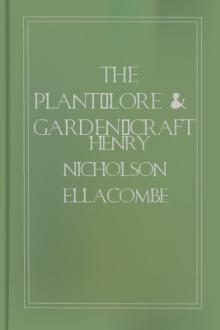The plant-lore & garden-craft of Shakespear, Henry Nicholson Ellacombe [read with me .TXT] 📗

- Author: Henry Nicholson Ellacombe
- Performer: -
Book online «The plant-lore & garden-craft of Shakespear, Henry Nicholson Ellacombe [read with me .TXT] 📗». Author Henry Nicholson Ellacombe
But we cannot dismiss the Lily without a few words of notice of its sacred character. It is the flower specially dedicated to the Virgin Mary, and which is so familiar to us in the old paintings of the Annunciation. But it has, of course, a still higher character as a sacred plant from the high honour placed on it by our Lord in the Sermon on the Mount. After all that has been written on "the Lilies of the field," critics have not yet decided whether any, and, if so, what particular plant was meant. Each Eastern traveller seems to have selected the flower that he most admired in Palestine, and then to pronounce that that must be the Lily referred to. Thus, at various times it has been decided to be the Rose, the Crown Imperial, the White Lily, the Chalcedonian Lily, the Oleander, the Wild Artichoke, the Sternbergia, the Tulip, and many others, but the most generally received opinion now is, that if a true Lily at all, the evidence runs most strongly in favour of the L. Chalcedonicum; but that Dean Stanley's view is more probably the correct one, that the term "Lily" is generic, alluding to the many beautiful flowers, both of the Lily family and others, which abound in Palestine. The question, though deeply interesting, is not one for which we need to be over-curious as to the true answer. All of us, and gardeners especially, may be thankful for the words which have thrown a never dying charm over our favourites, and have effectually stopped any foolish objections that may be brought against the deepest study of flowers, as a petty study, with no great results. To any such silly objections (and we often hear them) the answer is a very short and simple one—that we have been bidden by the very highest authority to "consider the Lilies."
FOOTNOTES:[140:1] This is a modern reading, the older and more correct reading is "twilled."
[142:1]
Appeared two lovely foes,
Aspiring to the rank of Queen,
The Lily and the Rose.
And yours the statelier mien,
And till a third surpasses you
Let each be deemed a Queen."—Cowper.
LIME. (1) Ariel. All prisoners, sir,
In the Line-grove which weather-fends your cell. Tempest, act v, sc. 1 (9). (2) Prospero. Come, hang them on this Line. Ibid., act iv, sc. 1 (193). (3) Stephano. Mistress Line, is not this my jerkin? Ibid., act iv, sc. 1 (235).
It is only in comparatively modern times that the old name of Line or Linden, or Lind,[146:1] has given place to Lime. The tree is a doubtful native, but has been long introduced, perhaps by the Romans. It is a very handsome tree when allowed room, but it bears clipping well, and so is very often tortured into the most unnatural shapes. It was a very favourite tree with our forefathers to plant in avenues, not only for its rapid growth, but also for the delicious scent of its flowers; but the large secretions of honey-dew which load the leaves, and the fact that it comes late into leaf and sheds its leaves very early, have rather thrown it out of favour of late years. As a useful tree it does not rank very high, except for wood-carvers, who highly prize its light, easily-cut wood, that keeps its shape, and is very little liable to crack or split either in the working or afterwards. Nearly all Grinling Gibbons' delicate carving is in Lime wood. To gardeners the Lime is further useful as furnishing the material for bast or bazen mats,[147:1] which are made from its bark, and interesting as being the origin of the name of Linnæus.
FOOTNOTES:[146:1] "Be ay of chier as light as lyf on Lynde."—Chaucer, The Clerkes Tale, l'envoi.
[147:1] "Between the barke and the woode of this tree, there bee thin pellicles or skins lying in many folds together, whereof are made bands and cords called Bazen ropes."—Philemon Holland's Pliny's Nat. Hist. xvi. 14. The chapter is headed "Of the Line or Linden Tree."
LING. Gonzalo. Now would I give a thousand furlongs of sea for an acre of barren ground, Ling, Heath, brown Furze, anything. Tempest, act i, sc. 1 (70).If this be the correct reading (and not Long Heath) the reference is to the Heather or Common Ling (Calluna vulgaris). This is the plant that is generally called Ling in the South of England, but in the North of England the name is given to the Cotton Grass (Eriophorum). It is very probable, however, that no particular plant is intended, but that it means any rough, wild vegetation, especially of open moors and heaths.
LOCUSTS. Iago. The food that to him now is as luscious as Locusts, shall be to him shortly as bitter as Coloquintida. Othello, act i, sc. 3 (354).The Locust is the fruit of the Carob tree (Ceratonia siliqua), a tree that grows naturally in many parts of the South of Europe, the Levant, and Syria, and is largely cultivated for its fruit.[148:1] These are like Beans, full of sweet pulp, and are given in Spain and other southern countries to horses, pigs, and cattle, and they are occasionally imported into England for the same purpose. The Carob was cultivated in England before Shakespeare's time. "They grow not in this countrie," says Lyte, "yet, for all that, they be sometimes in the gardens of some diligent Herboristes, but they be so small shrubbes that they can neither bring forth flowers nor fruite." It was also grown by Gerard, and Shakespeare may have seen it; but it is now very seldom seen in any collection, though the name is preserved among us, as the jeweller's carat weight is said to have derived its name from the Carob Beans, which were used for weighing small objects.
The origin of the tree being called Locust is a little curious. Readers of the New Testament, ignorant of Eastern customs, could not understand that St. John could feed on the insect locust, which, however, is now known to be a common and acceptable article of food, so they looked about for some solution of their difficulty, and decided that the Locusts were the tender shoots of the Carob tree, and that the wild honey was the luscious juice of the Carob fruit. Having got so far it was easy to go farther, and so the Carob soon got the names of St. John's Bread and St. John's Beans, and the monks of the desert showed the very trees by which St. John's life was supported. But though the Carob tree did not produce the locusts on which St. John fed, there is little or no doubt that "the husks which the swine did eat," and which the Prodigal Son longed for, were the produce of the Carob tree.
FOOTNOTES:[148:1] Pods of the Carob tree were found in a house at Pompeii. For an account of the use of the Locust as an article of food, both in ancient and modern times, see Hogg's "Classical Plants of Sicily," p. 114.
LONG PURPLES. Queen. There with fantastic garlands did she comeOf Crow-flowers, Nettles, Daisies, and Long Purples,
That liberal shepherds give a grosser name,
But our cold maids do Dead Men's Fingers call them. Hamlet, act iv, sc. 7 (169).
In "Flowers from Stratford-on-Avon" (a pretty book published a few years ago with plates of twelve of Shakespeare's flowers) it is said that "there can be no doubt that the Wild Arum is the plant alluded to by Shakespeare as forming part of the nosegay of the crazed Ophelia;" but the authoress gives no authority for this statement, and I believe that there can be no reasonable doubt that the Long Purples and Dead Men's Fingers are the common purple Orchises of the woods and meadows (Orchis morio, O. mascula, and O. maculata). The name of Dead Men's Fingers was given to them from the pale palmate roots of some of the species (O. latifolia, O. maculata, and Gymnadenia conopsea), and this seems to have been its more common name.
Catching each flower by the stalke,
Such as within the meddowes grew,
As Dead Man's Thumb and Harebell blew;
And as she pluckt them, still cried she,
Alas! there's none 'ere loved like me."
Roxburghe Ballads.
As to the other names to which the Queen alludes, we need not inquire too curiously; they are given in all their "liberality" and "grossness" in the old Herbals, but as common names they are, fortunately, extinct. The name of Dead Men's Fingers still lingers in a few places, but Long Purples has been transferred to a very different plant. It is named by Clare and Tennyson—
She'd wade o'er shoes to reach it in the dyke."
Clare's Village Minstrel, ii, 90.
Bramble Roses, faint and pale,
And Long Purples of the dale."
A Dirge, Tennyson.
But in both these passages the plant intended is the Lythrum salicaria, or Purple Loosestrife.
The meadow Orchis, though so common, is thus without any common English name; for though I have often asked country people for its name, I have never obtained one; and so it is another of those curious instances which are so hard to explain, where an old and common English word has been replaced by a Greek or Latin word, which must be entirely without meaning to nine-tenths of those who use it.[150:1] There are similar instances in Crocus, Cyclamen, Hyacinth, Narcissus, Anemone, Beet, Lichen, Polyanthus, Polypody, Asparagus, and others.
The Orchid family is certainly the most curious in the vegetable kingdom, as it is almost the most extensive, except the Grasses. Growing all over the world, in any climate, and in all kinds of situations, it numbers 3000 species, of which we have thirty-seven native species in England; and with their curious irregular flowers, often of very beautiful colours, and of wonderful quaintness and variety of shape, they are everywhere so distinct that the merest tyro in botany can separate them from any other flower, and the deepest student can find endless puzzles in them, and increasing interest.
Though the most beautiful are exotics, and are the chief ornaments of our stoves and hothouses, yet our native species are full of interest and beauty. Of their botanical interest we have a most convincing proof in Darwin's "Fertilization of Orchids," a book that is almost entirely confined to the British Orchids, and which, in its wonderfully





Comments (0)